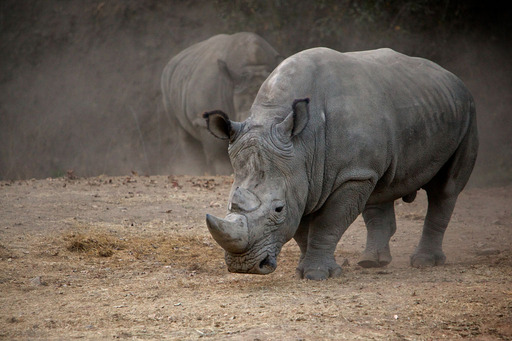Is the 70-200mm zoom lens
the most important glass in your camera bag? Many pros feel so. In today's podcast I explain why that's the one piece of photo gear I don't want to live without. Weddings, portraits, wildlife, landscape, events... you name it, I'm usually reaching for the 70-200. Listen in, and I'll give you some details.
 White Rhinoceros photographed with a Canon 70-200mm f/2.8 and a 1.4x Canon extender on a Canon 5D Mark II. Photo by Derrick Story. Click on image for larger version.
White Rhinoceros photographed with a Canon 70-200mm f/2.8 and a 1.4x Canon extender on a Canon 5D Mark II. Photo by Derrick Story. Click on image for larger version.
Listen to the Podcast
You can also download the podcast here (29 minutes). Or better yet, subscribe to the podcast in iTunes. You can support this podcast by purchasing the TDS iPhone App for only $2.99 from the Apple App Store.
Monthly Photo Assignment
Fall is the October 2010 Photo Assignment. You can read more about how to submit on our Member Participation page. Deadline for entry is Oct. 31, 2010.
TDS Spring 2011 Photography Workshop
We're making plans now for the Spring 2011 TDS Photography Workshop. If you want your name on the reserve list, just drop me a line.
More Ways to Participate
Want to share photos and talk with other members in our virtual camera club? Check out our Flickr Public Group. It's a blast!
Podcast Sponsors
Red River Paper -- Try the $7.99 Sample Kit.
Make Your Photos Sizzle with Color! -- SizzlPix is like High Definition TV for your photography.
Blurb believes passionately in the joy of books - reading them, making them, sharing them, and selling them. Learn more by visiting Blurb on The Digital Story.Technorati Tags:
digital photography, podcast, technique, Technology, The Digital Story, tips












Heck yes! I love that lens! 70-200 f/2.8L IS! :) And with the 1.4x extender and the 7D it's incredibly versatile.
I just got the 7D as a birthday present, so the lens isn't technically mine, but unless I somehow find the Mark II version before college, I'm taking it with me next year.
Nearly every version of that lens is great, especially recent editions of the Canon and Nikon f2.8 ones. And Canon's f4 IS is excellent for it's compactness and weight. While not the absolute sharpest of all lenses, the 70-200's are fantastic, especially the new canon. :)
I got this email from a listener, and it makes a lot of sense to me. Read it and see what you think:
"I was just listening to your podcast about the 70-200mm lens and heard you mention camera shake and the aps sensor sizes.
You stated that there would be more camera shake due to the "lens factor" rule but this isn't necessarily true.
The smaller sensor is a crop factor, not a focal length zoom factor.
The light passing through the lens isn't getting "painted" a greater ratio because of the crop.
Is this making any sense? I'm a photographer, not a physicist :)
I like to use a laser pointer as an example when taking camera shake to students.
The crop factor isn't changing the distant the light moves across the sensor, therefore sensor size doesn't effect camera shake, all other variables being constant.
Hope this clears things up a bit for you and the listeners."
Derrick I listened you podcast and couldn't agree more with the use of such a lens. I am a Nikon user but the 80-200 f/2.8 is my second most used lens, after the 12-24 f/4.
Anyway, I have a comment about the crop factor and shutter speed. I kind of disagree with the other listener and agree more with the initial idea of multiply the shutter speed by the crop factor.
I understand that the smaller sensor is just a crop factor and not a focal length zoom factor or like if you add the TC 1.4. Yet, a smaller sensor also means a smaller viewing angle out of the lens, therefore if the shutter rule of thumb was made for the viewing angle of the 35mm format, which is 1.5x bigger than the digital crop sensor, the shutter speed should be increased by the same factor.
In other words, 35mm format: shutter speed = 1/focal length, then on the digital cropped sensor: shutter speed = 1/1.5x focal length (1.6 for Canon).
This is anyway what I think. Great podcast anyway!!